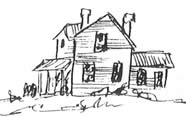There is a dignity and beauty in the weathered boards of a house that can remember a hundred years of history. The old handmade bricks and hand planed planks just ooze stories of good times and warm days as well as snowy days and Christmas wreaths. There is a character to a homemade brick that may still retain the print of a human finger, a print made from the very ground where it was used, that gives character to an old building. "Sometimes wish I could paint every one of these old structures."
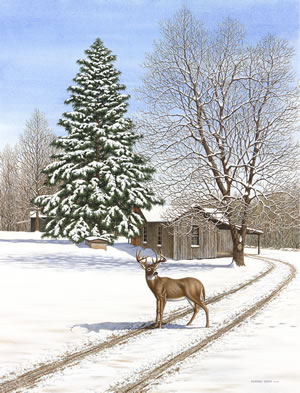
$120
"The Old Place"
For the most part, painters deal in natural beauty and nostalgia. Dempsey Essick is no exception. His aim in life has been to recognize the simple beauty in everyday scenes and objects and it has been his great good fortune to have the skill to record those scenes in memorable watercolor paintings.
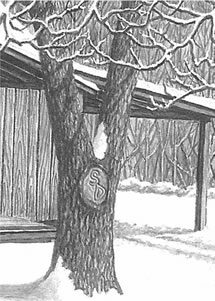
Dempsey will add no more than two initials to the knot of this tree.
For “The Old Place,” his latest painting, Dempsey has returned to his grandparent’s homestead where, as a young boy, he helped pull tobacco and enjoyed many hours on the farm.
As always the artist has hidden a rebus type image of a hummingbird in the painting.
Please note: Dempsey will, at no charge, add no more than two initials to the knot of the tree in the foreground. How special!
Dempsey Shares
“When I was a boy growing up during the 50’s and early 60’s time spent at Grandpa and Grandma’s house, which we called The Old Place, was special. I can still smell Grandma’s light rolls and country ham cooking. I have vivid memories of Grandma telling ghost stories at the tobacco barn during curing season. The time spent helping Grandpa pull tobacco was quite an experience.
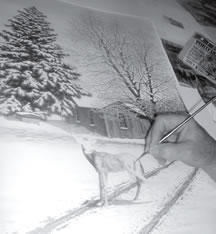
Dempsey working with his small paintbrush.
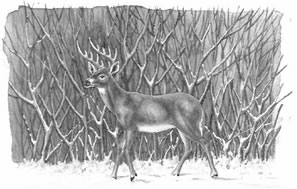
Dempsey completed this small study of a deer
in preparation for the painting.
I would drive Old Nick, Grandpa’s work horse, and make sure he pulled the sled in a straight line between the tobacco rows. When Nick did get out of the row, Grandpa had some choice words for him. My favorite time of the day was mid morning when Grandpa would go to the store and get us a drink and a snack (I always asked for a Pepsi and oatmeal cookie). Then at lunch time we would go to the house and eat a meal that Grandma had spent all morning preparing. I thought it was the best food I had ever eaten.”
“I had wanted to do a painting of the old place for a long time, so a couple of years ago, just after a beautiful snowfall; I found the perfect setting, with the tobacco barn in the background and the old house in the foreground. The snow covered evergreen completed the composition. The addition of the 11 point buck crossing the drive is a tribute to my late father, Billy Olen Essick, who was born at the old place and had a great love of deer hunting.”
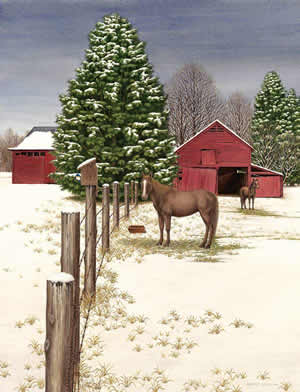
$120
Hidden Hummingbird: Yes
"Woodrow's Barn"
Snow in the Piedmont region of North Carolina has become a rare event. That’s why, when it does snow, I get my camera and hop into my Trailblazer with heated seats and head out to tour the local scenes that I have known all my life.
On March 2, 2009 we were gifted with a beautiful snow followed by a day of bright sunshine and I spent the entire day driving the country roads. I had a ball. A magic moment came when I drove down Craver Road and saw the old Woodrow Zimmerman Barn. The sight of the old red barn and the huge evergreen, with snow clinging to all its branches, and the friendly horses just captured my imagination. I knew right then that I had to save this special moment in a painting.
The horses that live in the old barn now belong to Dean Carter but the original occupants were the cows in the Zimmerman dairy herd. For many years Woodrow along with his father, Julian, and his brother, Russell, milked the cows, bottled the milk and delivered fresh milk daily to a list of customers throughout the Welcome and Arcadia communities and into the city of Lexington including the Coble Dairy.
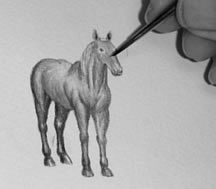
This is a study of a horse for “Woodrow’s Barn” done to practice technique and form before adding the subject to the actual painting. These small originals are sold in March which is Mini Original Month at the gallery.
Brother Russell was also a school teacher but Woodrow never wanted to be anything but a farmer. He once said, “I just enjoy seeing the soil tilled. I would rather plow than eat when I’m hungry.”
I not only wanted to capture the serene beauty of the old barn in the snow but I also wanted to pay tribute to men like Julian and Russell and Woodrow who were the same kind of hard working, self reliant men who took up muskets and fought with Washington in 1776 to win our country’s independence.
Pay close attention to the many details of the painting beginning with inside the barn. Secondly, since bluebirds do not migrate for the winter they make use of their bird boxes for warmth during the cold months. Look closely and you will see a bluebird perched outside his bird house. You will also enjoy looking as well for the hidden hummingbird in the painting.
Jeff Zimmerman Reflects

Jeff Zimmerman
My Uncle Woodrow was always happy and always had time to talk. Always a farmer, he was never in a hurry and still managed to get everything done. He and his wife Mildred were always together and enjoyed the wealth of the farm, land and produce as his dad had many years before. Woodrow, along with brother Russell and nephew Wade, continued to farm the family land and enjoy their labors of love. The third brother Millis moved to Burlington after college and started Zimmerman Lumber Company along with his wife, the late Bertha Snyder.
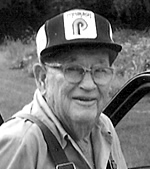
Woodrow Zimmerman
Having no kids of their own, Woodrow and Mildred (Craver) loved their many nieces, nephews, great nieces, great nephews and great greats. Many were around the house from time to time helping with the farm chores. Uncle Woodrow always jumped at the chance to employ the local teenage boys in the neighborhood to help with the many chores of farm life.
Always jolly, his belly jiggled as he was easily humored by a good laugh. Mid mornings, Woodrow could always be found at the local Link’s Fertilizer Store drinking a soft drink, eating his snack of the day and catching up on the over-night news. Many times I was in tow enjoying the same. My grandfather Russell, a teacher, coach and Principal at Wallburg Elementary School for 44 years and County Commissioner for years always joined in the farming chores of the Zimmerman Family land with his wife Inas (Kimel). Though the land was divided between the two brothers remaining at home, you would never know as they always worked together along with my dad Wade to complete the chores.
For myself, I grew up helping everyone along with my sister Lucinda, under the guidance of my mom Jane (Anderson) and my dad Wade. Though I complained many, many times per day about the difficult work on the farms of Russell and Woodrow, it never killed me but only made me a stronger more diversified person. My wife Cindy and I are very thankful that our kids, Danielle and Ryan, were able to be a part of the two family farms as they grew up and enjoyed the many days of love with Woodrow and Mildred. For a refreshing drink, Ryan and Danielle both vividly recall standing in Woodrow’s kitchen while helping Mildred make homemade Chocolate Milk using the original “Zimmerman Dairy” recipe that Woodrow delivered house-to-house in Lexington for many years before milk became readily available in the local country grocery stores. This original recipe has just been published for the first time in a cook book by Mt. Olivet United Methodist Church, where Woodrow and Mildred were life long members.
Woodrow’s Barn was always a home for many cows and their feed. I’ve placed many bales of hay in this old red barn that was built by Uncle Woodrow’s Grandfather, Eli Zimmerman, in the late 1800’s. As it was added on to over the years to accommodate the growing farm and dairy operation, the logs were covered with traditional lap siding to help preserve the structure. The barns and surrounding building have been unchanged as long as I can remember. The only change was the removal of the old washhouse/kitchen that was part of Woodrow’s old home place.
My sister, Lucinda Black, along with our mom Jane and I now lease the two farms to maintain their viability and preserve the family farm land. While growing up I never recall horses being in Woodrow’s Barn and it is a welcomed sight to see Woodrow’s Barn being enjoyed by God’s creatures and especially in God’s beautiful snow fall. Our family hopes you enjoy this painting as our family history becomes part of your family.
Jeff and wife Cindy live on Dr. Zimmerman Rd in Lexington, NC
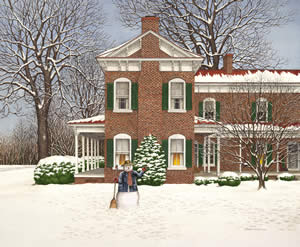
$120
"Snow Day"
Like a voice from the past, the old Riley Everhart Home Place on Center Church Road in the Welcome, NC Community has long been a landmark in Davidson County, NC. Built in 1885 with brick manufactured on the site the beautiful old home literally grew out of the land it dominates.
Back in 1885, when Riley and Molly Everhart bought the land from Lewis Berrier and then proceeded to build their two-story brick home, they weren't thinking of landmarks. They were thinking of a secure home where they could raise their growing family. Just a year later their security was rocked when the great Charleston Earthquake of 1886 reached all the way into North Carolina and cracked one of the walls upstairs in the new home. The crack is still there. It has never been repaired.
The Everhart Homeplace was in the hub of activity of the Arnold Triangle between 1890 and 1915.
Welcome Resident Ann Clodfelter, a granddaughter of Riley and Molly, remembers, in 1951, she and Reid passed the old earthquake crack as they started their descent of the stairs to their wedding in the living room on the ground floor. Ann can also tell about cutting wood for the fires and how a piece of heart pine was always saved to start the fire in the kitchen stove each morning. There were eight rooms and each room had its own fireplace. In cold weather, they would rake hot embers out onto the hearth and set a pan of water on the coals to heat for a bath. Everyone slept in just one of the big bedrooms until the girls were older as they were afraid to sleep upstairs. The most frightening thing was when someone would yell "The chimney's on fire!" Flames would shoot out the top of the chimney and hot coals would fall back and roll out on the floor and would have to be swept back onto the hearth so the house wouldn't catch on fire. A tin roof was a clear necessity in those days to avoid the danger of the home burning down.
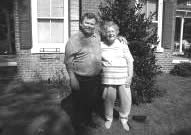
Ann Clodfelter stands with Dempsey
outside her old homeplace.
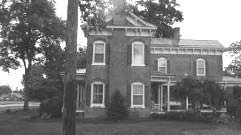
The Riley Everheart homeplace is located at
1587 Center Church Road in Welcome, NC.
Dempsey has captured, as only he can, the rustic beauty of a 19th century, Italianate brick farmhouse built of hand made brick with a lovely red tin roof and with decoratively buttressed eaves, arched windows, and end chimneys rising through pedimented gable ends typical for the era. The home was stylish in its day and is still stylish over a century later. The generous lawn and abundant shade trees along with wide porches add to the compelling lure of the old home.
The well dressed snowman adds a colorful touch to the winter scene and bird lovers will notice an Eastern Bluebird resting atop the snowman's broom.
Dempsey Shares
"As a young boy I passed the Riley Everhart home each day as I rode the school bus to and from Welcome Elementary School. It was the memory of those school days that inspired me to do the painting. One thing that I associate with the house is that it is on a hill high enough that when I passed by on the bus, I could look to the left and see Pilot Mountain in the distance."
"The house is an architectural masterpiece with all kinds of unique carpentry work throughout it. My dad, being the fine carpenter he was, would have appreciated the fine workmanship in this classic old home."
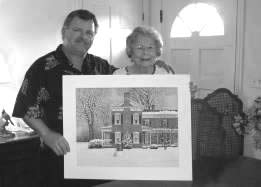
Ann was very pleased with the final presentation.
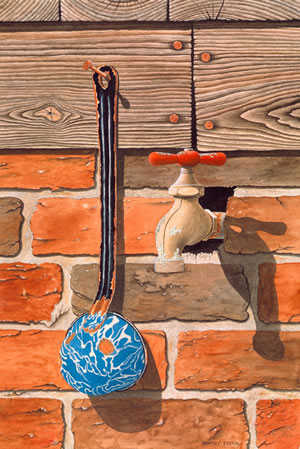
$45
"Pump House Shadows"
When you have been working outside under a hot sun for most of the day there is nothing in the world as refreshing as a dipper full of deep-well water cooled by nature. And after drinking your fill you can, perhaps, pour a dipperful over your head. It beats air conditioning for sheer instant relief. Then you can slap your ball cap back on your wet head and you are good for a few more hours on the tractor until you hear that welcome call to supper.
Dempsey Essick grew up on a farm so he is no stranger to tractors and plows and hot summer sun. In the days before farmhouses were air conditioned an electric fan in the parlor and a shady front porch were welcome respites from nature’s heat and for real relief all you had to do was walk out to the pump house and run a pitcher of that clear, tasteless water cooled to perfection by mother nature.
The painting covers just a bit more than a square foot of the side wall of the pump house on Dempsey’s Dad’s farm but, with Dempsey’s rendering of the exact details of the wood grain, the rough finish of the bricks with a broken out section for the water faucet, and the rusty nail with an enamel ware dipper the viewer can sense the shade trees around the farm house and the sounds of the cows at milking time. And, if you let your imagination run freely, you can smell the country ham and black-eyed peas cooking on the wood fired stove out in the kitchen.
Dempsey’s painting does what a painting should do. It fires up the imagination so that every time you stop and look at it, even if it does only cover a few square inches, you can picture the whole farm and hear the cows and the tractor and the sound of a rocking chair on the front porch and the sound of a breeze through the branches of the hickory nut tree.
“Pump House Shadows” groups well with “Wait Your Turn” which also features brickwork and the blue graniteware. A sister piece to “Pump House Shadows”, same size and coloration” is expected to be released in the near future.
A Word from Dempsey
“As a child, I spent many hours playing on and around our family's well house. I fought a lot of cowboys and killed a lot of Indians atop that old fort and I climbed it as a mountain many times to escape from bears and dragons. I would hang upside down and drink directly from the spigot and I remember being stung by a family of wasps that had built inside the pump house. Since we raised our kids in the same house where I grew up, I was thrilled years later to watch John and Beth doing the same things on top of that same old well house.”

$120
"Pisgah Covered Bridge"
Dempsey Essick had heard about the Pisgah Covered Bridge in Randolph County for years but had never visited the scene until last fall just after the leaves had dropped from the trees.
"I was at the new New Bridge Bank in Asheboro admiring the newly hung Essick Art when the subject of the covered bridge came up. New Bridge Purchasing Manager, Kathy Wilkerson, handed me a local magazine containing a photograph of the bridge in it and I was immediately drawn to it."
The scene stayed in Dempsey's mind, percolating like a strong pot of coffee, all winter. In February he had determined that this just had to be his next painting. He went again and began to select a point of view and to sketch and photograph the wonderful old wooden structure from every angle.
Asked about his reason for selecting the Pisgah Covered Bridge as the subject of a painting, Dempsey said that one of his favorite subjects had always been the series of paintings he did of the house at Two Meeting Street in Charleston, SC. But, from his first sighting of the old covered bridge in Randolph County he had felt that perhaps he had found a scene to challenge the Charleston paintings. "You have to be there and feel the antiquity," he said. "You have to stand by that old bridge and picture, in your mind, all the people and old wagons loaded with hay and all the buggies and hear in your mind the sound they make as they go over the old plans in the bridge."
Dempsey is at his artistic best when he is portraying an old wooden structure and the Pisgah Covered Bridge is no exception. His selection of a vantage point from the creek bed is designed to show the grand old bridge from the point of view of one of the woods creatures, a deer or a rabbit, or perhaps a chipmunk.
Plans were to release the painting in Spring but Dempsey's very nature and intensive technique would not allow it. "I could not rush it. Every leaf, stem, and branch had to be addressed. I had to do it justice and consequently it turned into a Fall Release"
The Pisgah Covered Bridge was built in 1903 and is located 12 miles south of Asheboro, NC. Turn right on State Road 1114 in the town of Ulah and the bridge is about eight miles on the left just past the Union Community Center. Picnic tables are provided and you will enjoy hiking around the trail.
Dempsey's Thoughts
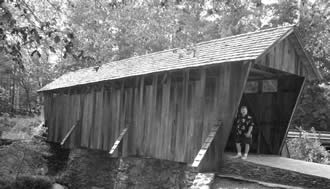
Dempsey on the Pisgah Covered Bridge
"The first time I walked to the Pisgah Covered Bridge, I stopped in my tracks as I looked at the wood boards and the rock foundation stones with all the shadows from the streamside trees. I listened to the ripple of the stream flowing under the bridge. The scene captured my imagination so that I could not wait to get started painting. Thousands of shadows cast from different directions created an image of abstract shapes that had wonderful order. I actually sat right there on a rock for a long time and breathed all this in.
As I got into this painting, I realized it was going to take much longer than I had anticipated to complete it. My personality as an artist is that I cannot take shortcuts; this is my strength and my weakness. When I paint trees I pay attention to the bark, the limbs, the shadows, and the knot holes When I paint rocks I detail their different shapes and colors and the moss growing on them. My goal is to portray the scene as natural as possible. To put it simply, I take as much time as is required and I cannot be rushed. I want the viewer to feel that they can walk right into the scene and sit down on the same rock I did. That is why "Pisgah Covered Bridge" took 560 hours to paint."
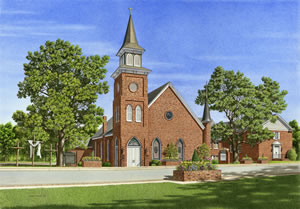
$150
Hidden Hummingbird: Yes
"Blessings of Grace"
"A church is more than the bricks and boards used in the structure." Dempsey Essick said. "A church is both a sanctuary and a beacon. The First United Methodist Church stands as the most prominent beacon on North Main Street in Mocksville. It is a beautiful building which reflects years of devotion and commitment on the part of a congregation with roots back to the very beginnings of this country."
Commissioned by the church to create an original painting to hang in its narthex, Dempsey set his sites on the long admired historic building. The painting title, "Blessings of Grace," was chosen by the FUMC congregation as an acknowledgment of God's promise of new life because of Easter morning.
"The two things that caught my eye about the church were the unusual double steeples and the stained glass windows." Essick said. "Now that I have completed the painting I have come to appreciate the many beautiful bricks and I feel as if I mortared and stacked every one of them."
For many years Dempsey Essick has said that ifhe didn't live in Davidson County he'd like to live in Davie. "My wife, Shelley, began her postal career in Mocksville," he said, "and I've been involved in the Davie Crafts Fair for many years. I've come to love the people and the town. I've even begun a 'Down Home in Davie' series which thus far has included the Davie County Courthouse as well as October's Treat which was a tribute to Granny Naylor and the 1. P. Green Milling Company."
"I am honored to have my work hanging in this historic church for members and visitors' alike to enjoy as they come to worship." Onlookers will enjoy searching for the rebus type image of a hummingbird hidden in the painting.
A Brief History of First United Methodist Church, Mocksville, North Carolina
by Mike Hendrix
The First United Methodist Church grew out of the Bethel Methodist Church located one mile east of Mocksville. In 1833 Jesse Clement of Mocksville went to Bethel to hear a sermon by CP. Moorman. Both Clement and his wife were converted to Methodism. Soon regular services were held at their plantation home on West Maple Avenue and other places in mocksville. On a lot given by Mrs. Lucretia Carter (where theMocksville Police Station presently stands) a white frame church was built with a balcony (for slave members) and steps leading up to two front doors.
In 1836 the church listed sixty-six members of which forty-one were slaves. In 1836 the Mocksville Circuit was formed by Davie County Methodist Churches. Formerly churches in Davie County were in the Salisbury Circuit. The new circuit was formed when Davie County was formed from Rowan County in 1836. In 1872 the Mocksville Circuit was divided into the Davie and the Mocksville Circuit. First Methodist continued as a part of a circuit until 1896 when the present sanctuary was built and the Mocksville church became a "station church." Two times in the 1800's the North Carolina Annual Conference met in Mocksville, first in 1840 and again in 1864. At both of these annual conferences town and county residents of all denominations helped to provide accommodations for ministers and horses. Also, Davie Country court was held in the first sanctuary after Davie County was formed in 1836. Davie County's first courthouse was not completed until 1839.
In 1891 plans were made for a new church building, and a lot was bought across Main Street from the original church. In 1894 the church sold forty feet of the new lot for a road, now Church Street. In 1895 the old church building was sold except for the foundation stones. By that year $1,481 had been raised for the new church. The present sanctuary was built and was dedicated in 1896 by Bishop Wallace Duncan.
In 1917 the first separate facility for Sunday School rooms was built. The "North Annex," as it was called, is currently used as youth Sunday School classrooms, the had bell choir room, and parlor. In 1918 a Delco plant was installed to produce lighting. In 1933 the South annex was completed to provide a small fellowship hall, indoor restrooms, and adult Sunday School rooms. The South annex currently houses the choir room, the church library, and a storage room. In 1955 a larger Fellowship Hall was added to church facilities. Today the old Fellowship Hall is divided into a Sunday School classroom and small fellowship hall.
In 1948-49 the sanctuary was remodeled. In 1957 the Education Building was constructed to house classrooms for children. Today the building houses the preschool programs and Sunday School classrooms. In 1973-74 the sanctuary was again remodeled, as were the North and South Annexes. The refurbished sanctuary and addition were dedicated by Bishop Earl G. Hunt, Jr. on February 22, 1976. The Education Building was redecorated in 1986-87. Property was purchased from the C.B. James estate in 1988 to allow for expansion possibilities for the future, and a parking lot was purchased in the 1990's.
The Heffner (later Food Lion) grocery store building was purchased by two church families in 2001 and presented to the church with the intention of converting the building into a Family Life Center. More than $1,200,000 was spent on this building which today houses a large fellowship hall with commercial kitchen, offices for church staff, large meeting rooms for Middle School and Senior High UMY groups, and facilities for scouting programs. The new Family Life Center was opened in 2002.
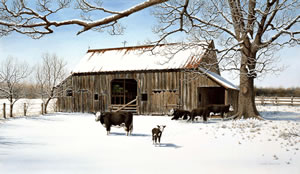
Sold out, unavailable
"5148 Hwy 8"
Back in the early 1900's when Cotton Grove Road running south out of Lexington, NC was just a two-lane, dirt wagon track, David Early Sink and Carrie Owens got married and settled on 110 acres of land on the edge of the Cotton Grove community. Over the next twenty years, David and Carrie had nine children of which seven survived birth. Inez was the oldest, followed by Clarence, Raymond, Archie, Homer, Maxwell, and Maxine.
The farm was the lifeblood and only source of income for the family. Each of the children worked in the fields, fed chickens and turkeys, slopped hogs, got up before daylight to hand milk from six to eight cows, churned butter, checked rabbit traps and cared for the horse, which was the family transportation, and the two mules, which were the source of power for everything from the plow to the disc harrow. And when school was in session, they caught the bus after morning chores, did evening chores after school and homework after supper. There was no television or even in the early years, radio. It was a way of life that built character and instilled the work ethic that is the backbone of this country.
Just a few years after he and Carrie were married, David built a barn. He used heart pine because he intended for the bam to last for years, and it has. Some of the boards are two feet wide and over twenty feet long. He put an opening on the front for each of the two mules and one in the southern lean-to for the horse. In the 1930's when David got his Ten-Twenty International tractor with the lugged metal wheels, he kept it in the lean-to on the north end.
As the years passed, the children married and moved away and had more children who in turn married, and now the extended family reaches far beyond Davidson County, North Carolina. The dirt road that the children once walked down barefoot to buy penny candy at the Cotton Grove Country Store, has been paved and is now NC HWY 8. For the boaters and fishermen headed for the High Rock Lace access ramp at Southmont, the old Sink barn is a landmark, notable because, unlike so many historic old barns, the Sink bam is still in daily use.
Dempsey Essick's return to the Cotton Grove community is a homecoming of sorts. It was the many requests for copies of his 1988 painting "Cotton Grove Country Store", which borders the Sink farm property, that convinced him to become a full time artist. Each time he passed by on Highway eight, he would tell himself that one day he would do a painting of the old barn.
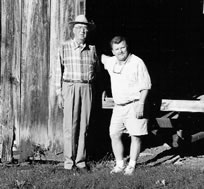
Archie Sink and Dempsey
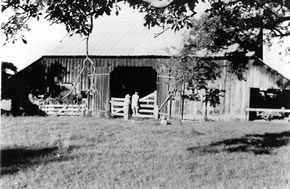
View of the Barn on Hwy 8
Dempsey's rendering captures the essence of the structure. The heart pine boards, which are still strong, have taken on that weathered grey color that is beautiful without adornment. He has depicted the bam on a morning just after a light snowfall and the light blanket of snow serves to highlight the metal roof and the straightforward, no non- Archie Sink and Dempsey Essick sense lines of the building.
Collectors of Dempsey's work know that he is at his best when depicting a subject of historical significance and he has done himself proud with this beautiful rendering of the barn located at "5148 HWY 8." No one painting in watercolor today is the equal of Dempsey Essick when it comes to depicting the texture, the grain, and the tactile sense of weathered wood. His lightly rusted metal roof and the gnarled old trees are as near perfect as is possible on a flat sheet of paper. Then, as if to remind us of his sense of humor, he has included with the livestock, a calf who has ventured forward to inspect the intruder in the barnyard, ready to turn and dash back to the protection of the mother at the snap of a finger, or the flip of a sable watercolor brush.
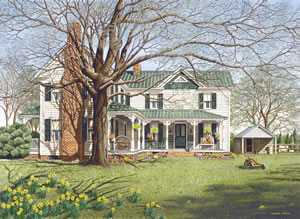
Sold out, unavailable
"Early Spring at the Fritts Farm"
It's everyone's dream of how a farm should look. For most of this century, travelers along the Winston Road north of Lexington, North Carolina, and passengers on the train next to the road, have been captivated by the sight of the Fritts Farm.
They first notice the big red barn surrounded by pastures with grazing cattle, then the green roofed house partially obscured by surrounding trees. It's a house with an unmistakable nineteenth century look; two stories with seven gables and covered porches on every side. It is obviously a dwelling built for a large family.
The new century had barely begun when David Thomas Fritts contracted with John Sink to build a new family home to accommodate his growing family. David eventually raised ten children in what was then called Maple Grove Farm. One of the Children, Charles Ray, and his wife, Helen, still lives in the house. Charles Ray's son, Henry, has restored the original loghome that his grandparents occupied.
In selecting a viewpoint, Essick has chosen the west face ofthe Fritts home because that is the side most familiar to people passing on the main road. For the same reason, he has painted the scene in early spring before the leaves conceal much of the building.
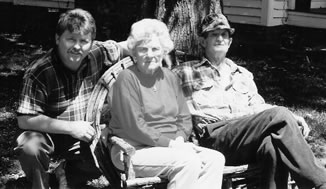
Dempsey with Helen & Charles Ray Fritts
All the characteristics of an Essick painting are present in "Early Spring at the Fritts Farm." His infinite attention to detail, his flawless use of light and shadow to give depth to the scenes and his sense of perspective and composition which puts the viewer in the scene as surely as if she had been seated in the Adirondack bent-willow chair on the Fritts side porch.
Dempsey Essick does not require the viewer to stand back several feet in order to get the full impact of his work. Rather, the viewer is invited to get up close and examine the detail of individual bricks in the chimney and the individual boards in the siding. The leaves, the blossoms, the blades of grass, all invite an examination and appreciation of the hours of meticulous brushwork that go into an Essick painting.
Look closely and you will see a cat on the porch, a rooster near the old smokehouse, and cows in the distance.
Dempsey's wife, Shelley, says that of all Dempsey has ever painted, "Early Spring at the Fritts Farm is my second favorite piece. The brickwork on the chimney and the shadows on the brick are breathtaking. I am amazed every time I look at the painting of this hundred year old home. I would love for Dempsey to do a second painting there of the Fritts barn."
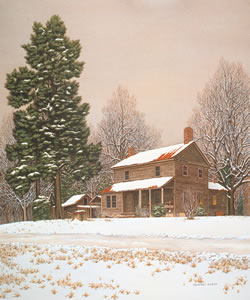
Sold out, unavailable
"Homeplace"
Old homesteads usually carry the name of the original owner/builder through the years. The 200 year old Hayden Place, on Wesley Chapel Road, in Davidson County, is no exception.
In 1797, after Jesse Hayden married Rosana Sloan, Rosana's daddy deeded the couple 646 acres of land along Potts Creek in the western part of the county near the Yadkin River. There the happy couple built their dream house. The house was occupied by Jesse and Rosana, and their descendants for the next 118 years before becoming a tenant farm after 1916.
Mrs. Vadie Queen, the 82 year old lady who has lived in the Hayden place for thirty-eight years, is true to the legacy of Jesse and Rosana. Mrs. Queen keeps chickens and still heats with wood and cooks on a wood stove.
Dempsey Essick chose to depict the "Homeplace" in winter when the snow provides suitable highlights for the old dwelling. The trees in the background are barren, allowing the towering cedar in the front yard to be the primary focal point of the picture.
The artist's trademark realism is manifest in every aspect of the twilight scene. The view is to the west where the sky is still light just after the cold winter sun has set. Slush in the road has refrozen so that the sound of passing vehicles reverberates in the still countryside.
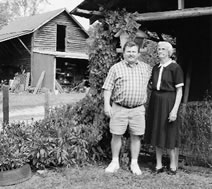
Dempsey & Vadie
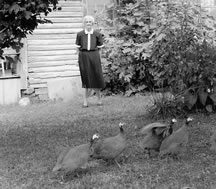
Vadie & Guineas
Admirers of Essick's work will be pleased with the wealth of detail in the "Homeplace." The hand-made bricks in the two chimneys; his rendering of each board and post in the house and out buildings; the delineating of each branch and twig in the leafless trees; all are elements of what has become the Essick touch.
The viewer, seeking relief from the stark cold depicted in the painting, is warmed by a glow from the kitchen window. Images come to mind of the family gathered around the supper table, talking, laughing, recounting the day's events.
In the meantime, a lone chicken can be seen scratching for food under the shrubbery.
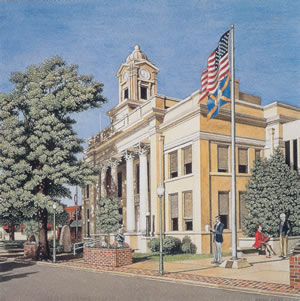
$50
"Davie County Courthouse"
The original Davie County Courthouse, the one built in 1837 in the center of the Mocksville town square, no longer exists. It stood for 85 years before giving way to the road pavers in 1922.
The old building had one feature that the newer structure does not have. That feature was a "shotgun" hallway straight through the building from the south to the north. Horseback riders, usually awash in Davie County corn byproducts, seemingly could not resist the temptation and would frequently spur their steeds through the front entrance, down the hall and out the back. If they did the "courthouse gallop" while court was in session, the presiding judge would usually fine the hapless horseman from ten to twenty-five dollars. In at least one instance, a rider, when fined ten dollars, gave the clerk a twenty dollar bill and said he'd just pay for a second ride while he was at it.
The present courthouse, as Dempsey Essick has portrayed it, was erected on the southeast comer of the town square in 1909.The building has been in continuous use since that date except for several months in 1916after a fire destroyed the roof and did major damage to the upper floor. A Daniel Boone family marker stands now at the northwest comer of the building, but some old timers might remember when one of R.J. Gatling's first practical machine guns stood on that spot to honor Davie County boys who served in the Spanish American War.
It's not likely that anyone still alive remembers the big bell on the roof of the building with the bell rope hanging down into the courtroom so the judge could yank on it to announce that the court was in session. But there may be some who can recall when sawdust was scattered on the floor to accommodate the tobacco chewers who aimed at, but sometimes missed, the spittoons. One veteran of the old time legal wars commented, "What with judges, lawyers, clerks, prisoners and witnesses, all with a wad in their respective cheeks and those big paddle bladed fans on the ceiling stirring up the air, no one is safe from the brown juice crossfire."
The architects who designed extensions which were added in 1971 and 1990, were careful not to detract from the Neo-Classical Revival Style of the originalbuilding. The building remains unchanged since being rebuilt after the aforementioned 1916 fire. The building is now listed in the National Register of Historic Places.
Identifiable in the picture is a lawyer has paused to wait for Judge Lester Martin, who has stopped to speak to longtime courthouse employee Sharri Campbell. The court room is named in honor of Judge Martin, who is one of the most respected judges in Davie County history. In the background, Postman, Dennis Howell, is entering the building with the day's mail.
Dempsey Essick has captured all the dignity and pristine beauty of a building that, for almost a century, has been the dominant landmark of the Davie County seat of government in Mocksville. He has carefully rendered every detail from the dome cupola, with its clock visible from any direction, to the unfluted columns, each standing on a massive base and each topped by a corinthian capital whose decorative acanthus leaves stand in contrast to the strong horizontal and vertical lines of the majestic old courthouse.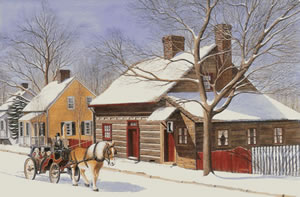
Sold out, unavailable
"First Tracks"
Dempsey Essick's latest painting is special in more ways than one. As a special release the limited edition print will help support First Night '93, the New Year's Eve Festival which provides young and old the opportunity to celebrate without the association of alcohol and drugs. As a symbol of our path through life, "First Tracks" illustrates the trail we leave behind and indicates a direction for the future. As a work of art, "First Tracks" is a significant addition to the artistic documentation of. the two hundred year old Moravian town of Old Salem in Winston-Salem, North Carolina.
Essick has captured a nostalgic scene showing Dr. Eddie Hill and his family on an early morning outing just after a fresh snowfall. The carriage is passing in front of three of the oldest dwellings on historic Salt Street.
The first house was built by the hatmaker, Solomon Lick, in 1822. The middle house was built in 1816 by John Hagen, a tailor and father of Francis Hagen, the musician and composer. The log dwelling was erected in 1787 by Martin Lick, one of the founding brothers of the original village. The famed poet, John Henry Boner, was born in this house in 1845 and makes numerous references in his poetry to the days he spent growing up here.
As the viewer is drawn deeper into the picture, details of Essick's meticulous brushwork become apparent. The grain of the logs in the Boner house, the fine detailing of the trim on the carriage, the subtle play of light and shadow on the snow, all combine to render a scene so realistic that one can almost hear the muffled sound of the horses hoofs on the snow covered street and feel the nip of winter in the air.
The overall effect of "First Tracks" is to leave the viewer with a feeling of having traveled back to Salt Street in the nineteenth century, perhaps to shop for one of Mr. Lick's hats, or to stroll up the street listening to Francis Hagen playing his Christmas song, "Morning Star," or perhaps to recall the words of one of John Boner's poems celebrating his days along the street where flowers grow.
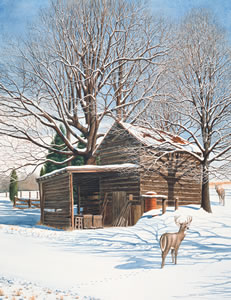
Sold out, unavailable
"Early Crossing"
In "Early Crossing," Dempsey Essick has captured a moment just after daybreak on a winter morning when two deer have claimed their right to make the first tracks in the new snow.
The setting is a familiar one to thousands of motorists who travel the road between Arcadia and Welcome in the northern part of Davidson County, North Carolina. The old log tobacco barn was built of hand hewn logs over a hundred years ago by William Craver and his father-in-law, Mike Evans. Kitty and Luther Craver, who live right across the road, remember having friends over for overnight sleep-outs when they'd turn the curing into a social event. When the youngsters finished high school, they were given a patch of tobacco to raise, cure and sell to pay their college tuition.
Years ago when I first started painting full time, I knew in the back of my mind that I would eventually paint the Craver tobacco barn. It is the kind of setting that appeals to me. Having grown up on a tobacco farm, I feel kinship to the way things used to be when so many of the old long curing barns were still in use. You could see slim columns of smoke rising up from them all over the countryside in the fall of the year after the tobacco crop had been harvested.
I depicted the scene early in the morning, just after daybreak, before any tracks had been made in the snow on the Welcome-Arcadia Road which passes just a few feet from the barn. And when I thought of a focal point for the picture, the deer and a buck, seemed natural both as a symbol of family and because deer are one of God's most beautiful creatures.
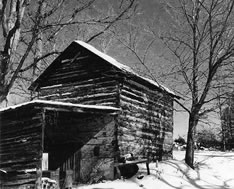
The old barn still stands today

The old barn stands cold now but, with a little imagination, the viewer can envision that first autumn, at the turn of the century, before the hewn logs turned grey, when the builders, William Craver and Mike Evans, put in their first crop of tobacco to be cured. It was the beginning of a tradition of hard work and all night fire tending vigils that lasted until the final crops were sold to pay college tuition for William's grandchildren.
The viewer, perhaps, remembering other quiet mornings when the grass was brittle underfoot and sounds echoed from barren fields, becomes engrossed in the scene, discovering one delight after another. The adze marks on the logs, a missing plank on the lean-to, some old tobacco sticks, the rust on the metal roof showing through the snow, are all pleasing.
inally, it is impossible to resist the trees. Hundreds of large and small branches intertwined and overlapping in a tangle that defies description except to say that it is a typical example of Dempsey Essick'skeen perception and detailed brushwork.
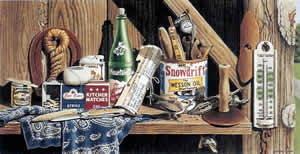
Sold out, unavailable
"Easy Pickins"
Every shed and garage has one. Usually referred to as the junk shelf, it's where all those items for which there is no regular peg or box, wind up. A cultivator blade, a hog scraper and an old mule shoe, all sharing a common shade of rust. The can for odd sized nuts, bolts and screws; a soft drink bottle half full of oil; these are the things that find a home on the junk shelf.
The shelf in "Easy Pickens" is located in a lean-to, beside Hubie Stafford's old tobacco barn in Guilford County, North Carolina. The hewn log barn was the subject of Dempsey's fall, 1993, release called "Hubie's Place".
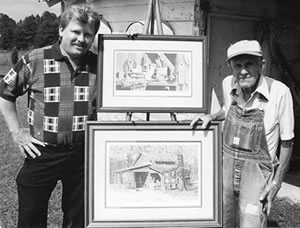
Dempsey with Hubie Stafford
Hubie's personal items; a bandanna, his snuff can and whittling knife, recall bygone autumn days when he would sleep in the shed because the wood fires had to be tended and the curing temperature had to be maintained around the clock.
The viewer, after discovering within the frame of the picture items as diverse as a broken folding rule and a box of wooden matches, comes away with the sense of having experienced a mini history of farming covering the era from animal drawn plows and wagons to present day trucks and tractors.
Almost lost among the inanimate objects, a flight of wasps stand ready to defend their nest while, just inches away, a sparrow returns time and again to carry off seeds from a dried okra pod, and in the process, give "Easy Pickens" its name.
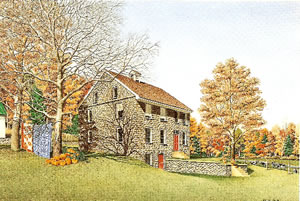
Sold out, unavailable
"Shades of Autumn"
Old houses draw Dempsey Essick to them like a magnet. No matter where he travels, the old buildings seem to call out to him. He is intrigued by their history and delighted by the people who preserve and live in the old structures.
The house in "Shades of Autumn" was built by Theodorus Eaby in 1727 near New Holland, Pennsylvania in the heart of Amish country. Recently the great-great, great-great, great-great grandson of Theodorus, Christian Eaby, and his wife, Dace bought and are restoring the old family homestead.
Dempsey has depicted the Eaby house as it appears on an Indian summer day with colorful foliage as a backdrop. His exact rendering of the stonework pays tribute to the workmanship of masons who erected the building over two and a half centuries ago. The scene harkens back to those early days when the paint on the doors and window frames was still fresh, pumpkins for Thanksgiving had been harvested, and the lady of the house had hung handmade quilts out to soak up the warmth of the fall sunshine. The realism is such that a viewer can almost smell the aroma of fresh baked bread and hear the bell in the rooftop cupola calling the workers in from the field while cows graze in the meadow.
"Shades of Autumn" enhances Dempsey Essick's reputation for seeking out historical subjects that reflect the early rural landscape of our country.
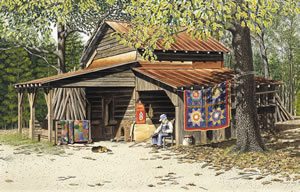
Sold out, unavailable
"Hubie's Place"
Years ago, as Labor Day drew near, columns of wood smoke from thousands of curing barns would appear in the southern skies as the new crop of tobacco was harvested and dried for the auction block. The farmers would sleep in sheds next to the barns in order to tend the fires and maintain an even heat around the clock.

Dempsey with Hubie Stafford
When Dempsey Essick first heard about Hubie Stafford, a Guilford County, North Carolina farmer who still cures tobacco in the old way, he knew that.it might be his only chance to capture a scene that has almost disappeared from the rural landscape. Hubie is perhaps the last of the breed. He is over eighty years old and still clings to the tried and true methods of farming he learned as a boy.
In "Hubie's Place," Dempsey has captured the feel of a September morning near the end of the harvest season. Hubie's handmade quilts, being aired in the soft sunshine, add a touch of color to a picture dominated by the rusty brown of the barn roof and the weathered, hand hewn logs of the building itself.
Dempsey has pictured Hubie at his favorite curing-time diversion, sitting in front of the shed where he spent the night, whittling on a tobacco stick, while his old dog relaxes nearby. An early drop of leaves from the oak tree marks the last tranquil days of summer and the approach of autumn which is just over the horizon.
Dempsey's Thoughts
When I saw Hubie's barn for the fist time it was like a trip back to the days when I was growing up on the farm. I remembered getting up at daylight during the week, pulling tobacco and loading sleds all day then jumping in the pond to wash off the tobacco gum. We would spend the week loading the barn then sit up all night to tend fires on Saturday. We made the weekend into a combination family get-together, camp-out and picnic. There was always plenty of country cooking and marshmallows to toast, and sometimes we'd cut a watermelon fresh out of the field.
That was just part of the memories that went through my head when I first stood in from of "Hubie's Place". Meeting Hubie himself was a delightful experience. His is one of that old breed of farmers who is more comfortable outside; more at home on a tractor than in an air conditioned car.
Hubie is over eighty years old. He as a wonderful sense of humor and a zest for life that would do credit to a person half his age. He has worn out more overhalls than I have socks and when I went out to spend the day with him, working in the field, he wore me out. The experience served to remind me why I decided years ago not to be a tobacco farmer.
I was lucky to grow up in the country amoung the hard working, honest farm folks who are the salt of the earth. That's why "Hubie's Place" is important to me, because I consider it to be my tribute not just to tobacco farmers but to farmers of all kinds, everywhere.
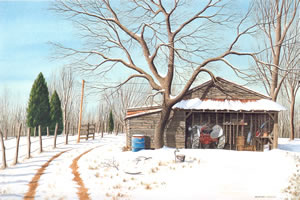
Sold out, unavailable
"Spring Thaw"
The old tractor shed on highway 150, in the northern part of Davidson County, North Carolina, originally caught my attention because it was so much like the one on my dad's farm, where I grew up. Every time I would drive by it seemed to draw my eyes like a magnet. Then, one day about two years ago, just after the last snow of the season, I saw the picture I wanted. The snow was beginning to melt under a sunny sky which gave me the contrast of strong shadows from trees and fence posts and the snow on the-ground reflected enough light into the shed to reveal tools, gas cans and equipment that had been stored for the winter. The only thing missing was a tractor. You can't have a tractor shed without a tractor so, what you see in the painting is the back end of my dad's tractor.
Old buildings have always appealed to me. I like to learn their history - who built them and when. I didn't expect to learn much from the history of an old farm shed so you can imagine my surprise when I met Mrs. Irene Miller and found out that this shed was originall y a Gulf service station and country store. The building was put up by Mrs. Miller's father-in-law, David Miller, in the 1920's and, for almost three decades, it was known as the "D.K. Miller Service Station".

Dempsey on his Dad's
Red Belly Ford Tractor
Mrs. Miller showed me some remembrances from when the store was a thriving business. She has a patio table that her husband, Odell, made from the big, round, Gulf sign that once hung out by the highway. And there was a clipboard full of credit slips from the 1930's showing sales of gasoline at ten cents a gallon, coffee at fifteen cents a pound and Tuberose snuff at ten cents a can. Looking through the slips I could picture, in my mind, country ladies in gingham dresses, passing out the latest news on who was getting marrried or having a baby and the men in bib overalls, discussing the Hoover/Roosevelt campaign and children buying stick candy, with a shiny prize ring around each stick, for a penny.
The advent of supermarkets, a changed road and the beginning of gas rationing during World War II, forced the D.K. Miller Service Station out of business early in the 1940's. Mr. Miller moved the building a hundred yards west of its old location and it served out the remainder of its days as a tractor shed.
I painted Spring Thaw in March, 1990, and it got so much favorable comment at shows in Winston-Salem, Lexington, Gastonia and High Point, with many people saying that they would like to have a print, that I decided to use it for my spring release. Just a few months after I had completed the painting, the old building was torn down and the tree in front was removed so now, after years of duty as a service station, store and shelter for farm equipment, the scene you see in Spring Thaw is just a pleasant memory.
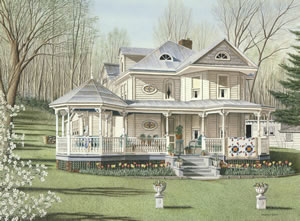
Sold out, unavailable
"Springtime at Irena's"
The first time I saw Irena McCormick's home was in 1988. I was on my way to visit my sister in Charlottesville when, after several hours on the road, I saw this wonderful house right next to U.S. Highway 29 in the small community of Covesville, Virginia.
The architecture was remarkable with its gables and steep pitched roof, and small, stained glass windows. And there was a gazebo built right onto the front porch. On subsequent trips I found myself looking forward to Covesville and the house with the gazebo. It became my landmark, and I suppose it was inevitable that it would become the subject for one of my paintings.
When I met Mrs. McCormick, I found a five-foot bundle of humor with sparkling blue eyes and a zest for life that would be commendable in someone half her 103 years. Best of all, I discovered that she is a fellow artist. She showed me some of her oil paintings, which are very good, and her quilts, which demonstrate a natural grasp of color, balance, and design.
Remembering Irena's
by Dempsey Essick
With kindred spirit the
Hummingbird and I
Revisit Irena's in warm
Summertime
Seeking the nourishment
Of days gone by
We breathe in the
Sweet nectar with a sigh
With no regard for the
Weathered railing
The sun shines bright
On this blessed dwelling
As flourishing blooms give
A place that's shady
Our hearts are stirred
Remembering a special lady
With that background I was not surprised to learn that she had designed the house herself. It was originally a small, four-room dwelling when she and her husband, A.W. Norvelle, the railroad telegrapher with whom she eloped just after graduating from high school, bought the property. The four-room house became the core around which "Concaw," as her grandchildren call her, made additions according to a plan that she carried in her head, to accommodate a growing family which eventually included seven children.
The crowning touch was the porch. "I had always wanted a big porch ... with some roundness to it," she said. And she cut and nailed every; board in the porch floor herself.
After Mr. Norvelle died, she married Emmett McCormick and for ten years the house was known as "The Maple Lawn Tourist Home." This was in the days before motels sprouted along the highways.
Her guests came from all over the United States, Canada and Europe. All were welcomed and fed, including dogs, cats and even a monkey and a parrot. Some of her guests would return year after year and she made lifelong friends who would write to tell her of their travels and fondly recall the croquet games on the front lawn and the southern cooking.
Concaw traveled also - all across the country and into Canada, but she was always anxious to get back to Covesville and her dream house where she could sit on the swing in her gazebo and read and watch the travelers go by on Highway 29.
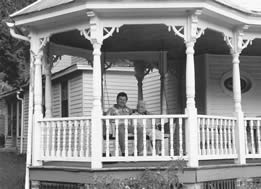
Dempsey & Irena on her porch swing
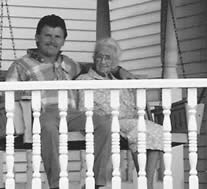
Dempsey & Irena
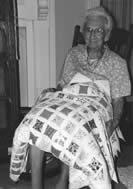
Irena with her quilt
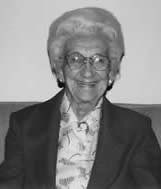
Irena McCormick
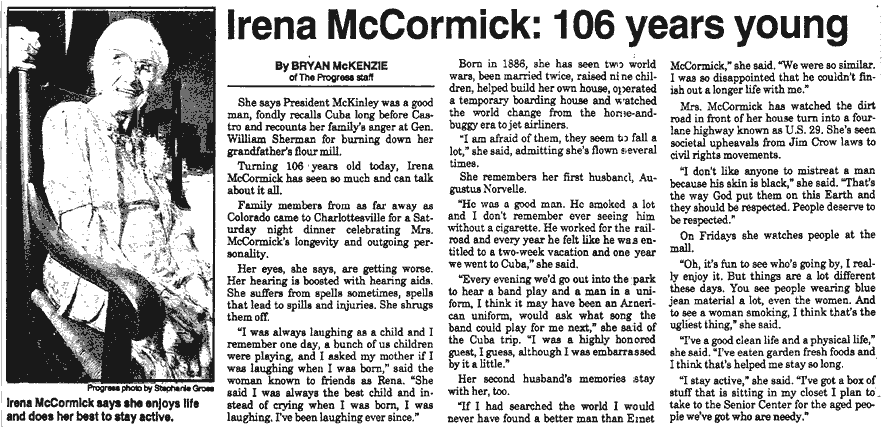

Sold out, unavailable
"Good Morning Miss DeLapp"
Alice DeLapp, wearing her distinctive split-bonnet, was so much a part of the 103 year old farm home, where she was born and where she lived for eighty one years, that Dempsey Essick felt compelled to include her in his painting of the DeLapp Home Place - one of the earliest structures in the Reedy Creek Community of Davidson County, North Carolina.
Dempsey's painting evokes a nostalgia for the smell of bread baking in the wood-fired range and the quiet country places and friendly country people that he loves.
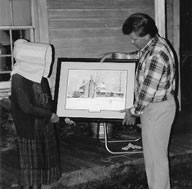
Miss Alice DeLapp & Dempsey
The warm quality of the morning sun in contrast with the bold shadows of bare limbs reaching across the snow to embrace the weathered boards of the 1889 dwelling, all serve to capture the essence of farm life as it was in times gone by. The house still stands today and is enjoyed by those traveling US Hwy 150.
Miss Alice DeLapp was a first grade school teacher at Reedy Creek Elementary School who never married but cared for her parents. Working on this project was one of my fondest memories. Miss Alice was a real lady.
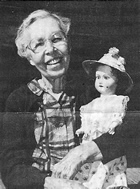
Tribute to a Special Lady
Miss Alice DeLapp passed away on January 21 1991, just two days after her 82nd birthday. My life is richer for having known Aunt Alice. She was a beautiful lady with a warm wonderful smile that she bestowed generously on everone she met. She had the serene dignity that comes to those who are at peace with themselves. When I pass her home I still automatically, look to see if she is out in the yard in her sunbonnet, going about her business of attending to her flowers. It is then, when I realize that I can never again turn into her driveway and spend a few moments enjoying her company, that I miss the most.
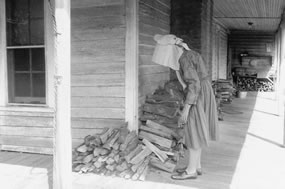
Miss Alice DeLapp
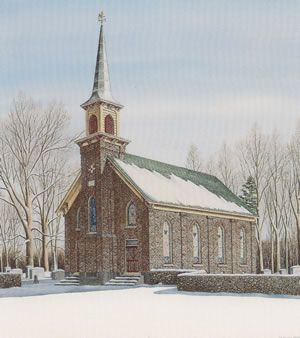
Sold out, unavailable
"Winter Afternoon at Fulton"
In a special release to help raise funds for its restoration, Dempsey Essick has portrayed the Fulton Church rising from an unbroken field of pure white snow, its slender spire pointing to the heavens and every detail, from the handmade brickwork to its classic, lancet arched windows and belfry, all defined in minute detail.
The Fulton Methodist Church has been a landmark on route 108, two miles northeast of the Fork Community in Davie County, North Carolina since 1888. Bricks used in the building were made on the site by employees of the Hanes family, who also donated the land. After the new church was built on the same site in 1969, the old building fell into disrepair and was in danger of being lost forever until concerned friends started a restoration project to return the distinctive old structure, which is on the National Register of Historic Sites, to its original stately beauty.
In "Winter Afternoon at Fulton", Dempsey has captured all the dignity and elegance of an early country church whose bell will ring out a call to worship into another century.
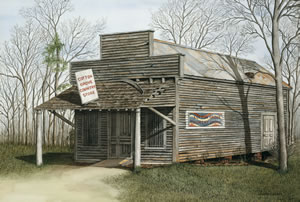
Sold out, unavailable
"Cottongrove Country Store"
En route to her job as Postmaster in the small community of Southmont, NC Shelley Essick daily passed the old derelict and run down Cottongrove Country Store on Hwy 8. She had for over two years begged Dempsey to do a watercolor of the local landmark to hang in her quaint little office. When she finally received it as a Christmas gift in 1988 she was thrilled.
The couple took the painting to be framed and when picking it up they were told that the shopkeeper had taken orders for 50 prints. "We were shocked as we had never considered doing prints," Dempsey said. Amazed, they took the painting to another frame shop and there received the same response. Up until now Dempsey had painted only for a hobby and he was quite shocked with all that had taken place.
To shorten up a long story, Dempsey borrowed the money to have 500 prints made and every copy sold out within two weeks time. So Dempsey began to paint and the public loved it. With the support of his wife and children, he quit his 9-5 job to devote full time to his paintbrush.
